Do you have a question about the Can-Am Spyder RT 2019 and is the answer not in the manual?
Essential sections to read before operating the vehicle for safety.
Explanation of safety message symbols and their usage in the guide.
Information on the guide's origin, scope, and how to obtain extra copies.
Acknowledgement of the Motorcycle Safety Foundation (MSF).
Precautions to prevent injury or death from carbon monoxide.
Instructions to reduce the risk of fire or explosion from gasoline.
Warning to avoid contact with hot engine and exhaust system parts.
Caution against unauthorized modifications and accessories.
Location and operation of essential controls like handlebar, throttle, and gearshift.
Details on ignition, start/stop switches, hazard lights, cruise control, and lights.
Controls for passenger heated grips and audio system.
Functions, navigation, and indicators of the main digital display.
Instructions for adjusting mirrors for optimal visibility.
Procedure for opening and locking the glove box.
Procedure for opening and accessing the front storage compartment.
Procedure for opening and accessing the operator seat.
Instructions for opening and securing side and top storage compartments.
Instructions for securing a helmet using the provided hooks.
Location of the tool kit and its contents for basic maintenance.
Location of the operator's guide within the vehicle.
Information on removal and installation of various body panels for maintenance.
Steps to adjust the passenger footrest height for comfort.
Detailed procedure for starting and stopping the vehicle's engine.
Instructions for safely moving the vehicle without starting the engine.
Guidance on shifting into and driving in reverse.
Information on the required break-in period for the vehicle.
Requirements and procedures for refueling the vehicle.
Guidance on adjusting rear suspension pressure for load changes.
How to connect and use audio devices via the input jack.
Understanding unique features and operating characteristics compared to other vehicles.
Explanation of systems like VSS and DPS that assist driving.
Factors contributing to riding risk and how to manage them.
Recommendations for protective gear for rider and passenger.
Exercises to develop basic riding skills and control.
Strategies to reduce risk and improve visibility on the road.
Guidelines on weight limits, carrying passengers, cargo, and towing.
A quiz to test understanding of the operator's guide content.
Details about hang tags, safety cards, and vehicle labels.
Information on how to report vehicle safety defects to BRP and NHTSA.
A guide to performing essential checks before each ride.
Recommended maintenance intervals for the vehicle.
Details and recommendations for the initial vehicle inspection.
Instructions for essential maintenance tasks like oil and filter changes.
Proper methods for washing and drying the vehicle.
Recommendations for protecting plastic parts and paint finishes.
Procedures for preparing and storing the vehicle for extended periods.
Steps to prepare the vehicle before riding after storage.
Troubleshooting steps when the vehicle cannot shift into neutral.
Action to take when the vehicle will not shift gears.
Troubleshooting when the engine fails to start.
Explanation of indicator lamps and warning messages on the gauge.
Procedure for lost keys and replacement of ignition components.
Steps to open the side storage compartment if it is stuck.
Instructions for temporary repair or transport for a flat tire.
Procedure for jump starting a dead battery.
Location, identification, and replacement of vehicle fuses.
Information on replacing headlights, turn signals, and other lights.
Location of VIN and model numbers for identification.
Vehicle emission control information and vacuum hose routing.
Regulations regarding tampering with the noise control system.
FCC and Industry Canada compliance for RF D.E.S.S. key.
Regulatory compliance information for the multifunction gauge.
Technical details of the engine, including type, displacement, and lubrication.
Specifications for the SE6 sequential electronic gearbox.
Details on the liquid-cooled system with radiators and fans.
Information on ignition, battery, headlights, and lighting specifications.
Details on fuel delivery, fuel pump, and idle speed.
Specifications for the drive system, including belt type and ratio.
Information on the Dynamic Power Steering (DPS) system.
Specifications for the front suspension and shock absorbers.
Details on rear suspension types, travel, and preload adjustments.
Specifications for front and rear brakes, fluid, and pad thickness.
Recommended tire types, pressure, and tread depth specifications.
Specifications for wheel size and torque values.
Vehicle dimensions including length, width, height, and wheelbase.
Details on dry weight, compartment capacities, and load limits.
Scope, limitations, exclusions, and coverage period for the limited warranty.
Warranty coverage for emissions control system components.
Warranty terms for products sold outside USA and Canada.
Specific emission control warranty rights and obligations for California.
How customer data is used for safety, warranty, and marketing purposes.
Contact details for BRP worldwide offices.
Procedure for notifying BRP of address or ownership changes.
Essential sections to read before operating the vehicle for safety.
Explanation of safety message symbols and their usage in the guide.
Information on the guide's origin, scope, and how to obtain extra copies.
Acknowledgement of the Motorcycle Safety Foundation (MSF).
Precautions to prevent injury or death from carbon monoxide.
Instructions to reduce the risk of fire or explosion from gasoline.
Warning to avoid contact with hot engine and exhaust system parts.
Caution against unauthorized modifications and accessories.
Location and operation of essential controls like handlebar, throttle, and gearshift.
Details on ignition, start/stop switches, hazard lights, cruise control, and lights.
Controls for passenger heated grips and audio system.
Functions, navigation, and indicators of the main digital display.
Instructions for adjusting mirrors for optimal visibility.
Procedure for opening and locking the glove box.
Procedure for opening and accessing the front storage compartment.
Procedure for opening and accessing the operator seat.
Instructions for opening and securing side and top storage compartments.
Instructions for securing a helmet using the provided hooks.
Location of the tool kit and its contents for basic maintenance.
Location of the operator's guide within the vehicle.
Information on removal and installation of various body panels for maintenance.
Steps to adjust the passenger footrest height for comfort.
Detailed procedure for starting and stopping the vehicle's engine.
Instructions for safely moving the vehicle without starting the engine.
Guidance on shifting into and driving in reverse.
Information on the required break-in period for the vehicle.
Requirements and procedures for refueling the vehicle.
Guidance on adjusting rear suspension pressure for load changes.
How to connect and use audio devices via the input jack.
Understanding unique features and operating characteristics compared to other vehicles.
Explanation of systems like VSS and DPS that assist driving.
Factors contributing to riding risk and how to manage them.
Recommendations for protective gear for rider and passenger.
Exercises to develop basic riding skills and control.
Strategies to reduce risk and improve visibility on the road.
Guidelines on weight limits, carrying passengers, cargo, and towing.
A quiz to test understanding of the operator's guide content.
Details about hang tags, safety cards, and vehicle labels.
Information on how to report vehicle safety defects to BRP and NHTSA.
A guide to performing essential checks before each ride.
Recommended maintenance intervals for the vehicle.
Details and recommendations for the initial vehicle inspection.
Instructions for essential maintenance tasks like oil and filter changes.
Proper methods for washing and drying the vehicle.
Recommendations for protecting plastic parts and paint finishes.
Procedures for preparing and storing the vehicle for extended periods.
Steps to prepare the vehicle before riding after storage.
Troubleshooting steps when the vehicle cannot shift into neutral.
Action to take when the vehicle will not shift gears.
Troubleshooting when the engine fails to start.
Explanation of indicator lamps and warning messages on the gauge.
Procedure for lost keys and replacement of ignition components.
Steps to open the side storage compartment if it is stuck.
Instructions for temporary repair or transport for a flat tire.
Procedure for jump starting a dead battery.
Location, identification, and replacement of vehicle fuses.
Information on replacing headlights, turn signals, and other lights.
Location of VIN and model numbers for identification.
Vehicle emission control information and vacuum hose routing.
Regulations regarding tampering with the noise control system.
FCC and Industry Canada compliance for RF D.E.S.S. key.
Regulatory compliance information for the multifunction gauge.
Technical details of the engine, including type, displacement, and lubrication.
Specifications for the SE6 sequential electronic gearbox.
Details on the liquid-cooled system with radiators and fans.
Information on ignition, battery, headlights, and lighting specifications.
Details on fuel delivery, fuel pump, and idle speed.
Specifications for the drive system, including belt type and ratio.
Information on the Dynamic Power Steering (DPS) system.
Specifications for the front suspension and shock absorbers.
Details on rear suspension types, travel, and preload adjustments.
Specifications for front and rear brakes, fluid, and pad thickness.
Recommended tire types, pressure, and tread depth specifications.
Specifications for wheel size and torque values.
Vehicle dimensions including length, width, height, and wheelbase.
Details on dry weight, compartment capacities, and load limits.
Scope, limitations, exclusions, and coverage period for the limited warranty.
Warranty coverage for emissions control system components.
Warranty terms for products sold outside USA and Canada.
Specific emission control warranty rights and obligations for California.
How customer data is used for safety, warranty, and marketing purposes.
Contact details for BRP worldwide offices.
Procedure for notifying BRP of address or ownership changes.
| Brand | Can-Am |
|---|---|
| Model | Spyder RT 2019 |
| Category | Motorcycle |
| Language | English |
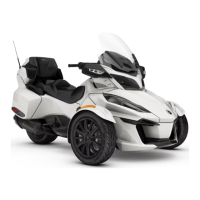
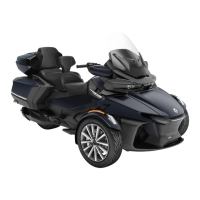
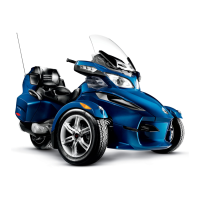
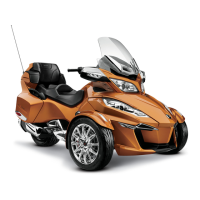
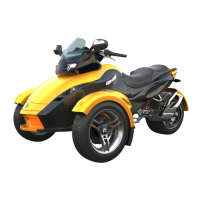
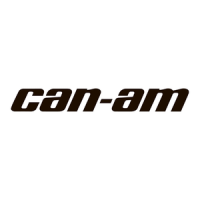

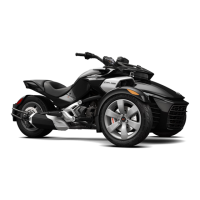

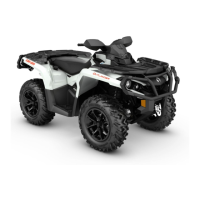
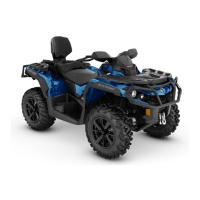
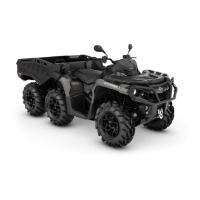
